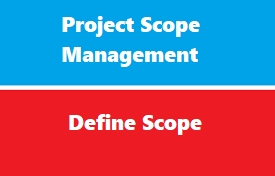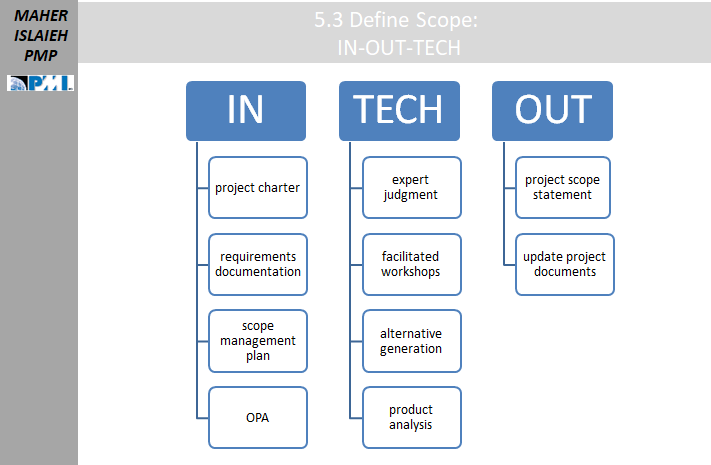introduction
this article we will discus third process of scope management area which called : define scope
Define Scope is a process of developing a detailed description of the project and product. The key benefit of the Define Scope process is that it describes the project’s boundaries by defining which of the requirements collected will be included in the project.
define scope concepts
define scope process concern what is included and what is NOT included in project
The process uses project charter and scope management plan and requirements collected in previous process to define only scope required to finish project successfully
As we know that planning is iterative : so when scope define at first time and go to plan all other knowledge areas like time , cost , quality , Risk
then project manager will back again to refine and enhance final scope as per effects from other constraints
Product analysis : the purpose of product analysis is to analyze objectives and descriptions that stated at project charter and covert it to tangible and achievable deliverables
Project scope statements says (what we will done at this project )
define scope : inputs-outputs-tools-techniques
Inputs
- project charter
- requirements documentation
- scope management plan
- OPA
Techniques
- expert judgment
- facilitated workshops
- alternative generation
- product analysis
Outputs
- project scope statement
- update project documents
input : project documents
Examples of project documents that can be listed as inputs for defining scope are as follows;
Assumption Log
- The role of the assumption log is to identify the assumptions and constraints about the project, product, stakeholders, environment and other factors that can influence the project and the product scope.
Requirements Documentation
- The process of identifying the list of requirements that are to be incorporated into the project scope.
Risk Register
- The risk register mainly contains response strategies that may affect the project scope by reducing the project and the product scope to avoid or mitigate a risk that is to occur in the project.
input : Enterprise Environmental Factors
The factors which can influence the Define Scope process include:
- Organization’s Culture
- Infrastructure
- Personnel Administration
- Marketplace Conditions
input : Organizational Process Assets
The factors that influence the Define Scope process include:
- Policies, procedures, and templates for a project scope statement
- Project files from previous projects
- Lessons learned from previous phases and projects
Tools and Techniques
Expert Judgment
With regards to the technique of expert judgment, one has always to consult a group or an individual who has exceptional knowledge in dealing with similar projects.
Data Analysis
The best example of a data analysis technique that can be used in this process is alternatives analysis. This alternatives analysis helps in evaluating ways to meet the requirements and objectives that are identified in the project charter.
Decision Making
Multi criteria Decision Analysis is the best example of this particular process. Under this technique, a decision matrix is used to provide a systematic analytical approach for establishing necessities like requirements, schedules, budget, and resources to clarify the project and product scope further.
Interpersonal and Team Skills
An example of interpersonal and team skills is facilitation process. This process is mainly used in workshops and sessions happening with key stakeholders who are always high on expectations. The ultimate goal of this process is to reach a cross-functional and shared understanding of the project deliverables.
Product Analysis
Product analysis is used to define the products and services related to a particular project. The process includes asking questions about a product or service and generating answers to describe the use, characteristics, and other relevant aspects of what is going to be delivered.
The following are the examples related to the product analysis process:
- Product breakdown
- Requirements analysis
- Systems analysis
- Systems engineering
- Value analysis
- Value engineering
output : project scope statement
Project Scope Statement is a detailed description of the project scope, which includes significant :
- deliverables,
- assumptions,
- and constraints.
It also documents the project scope and the product scope and describes the project’s deliverables and the work required to deliver them. Based on the level and degree of detail the project scope statement defines the work that will be performed,
and the work that is minimized can help determine how well the project management team can control the overall project scope.
Scope Statement components
Project Scope Statement include the following but NOT limited to :
- product scope descriptions
- acceptance criteria
- deliverables
- project exclusion (Out SOW)
- constraints: restriction and limitation that affect project execution
- assumptions : factors in planning process that considered to be true without need proof or demonstration
output : Updates Project Documents
Assumption Log
- The role of assumption log at this stage is to update the log with additional assumptions or constraints which were identified during the project process.
Stakeholder Register
- The documentation that consists of all of the stakeholder’s requirements that are to be met and also registers the important deliverables that are in the pipeline of the project manager.
Requirements Documentation
- A method that is used to record the requirements of a particular project. This documentation will keep of all the deliverables that are met and the other deliverables that are to be accomplished by the project manager.
Requirements Traceability Matrix
- A method that is used to compare the project’s scope, requirements and deliverables are all the same when they are compared with the project’s baseline that was created during the project management plan.


